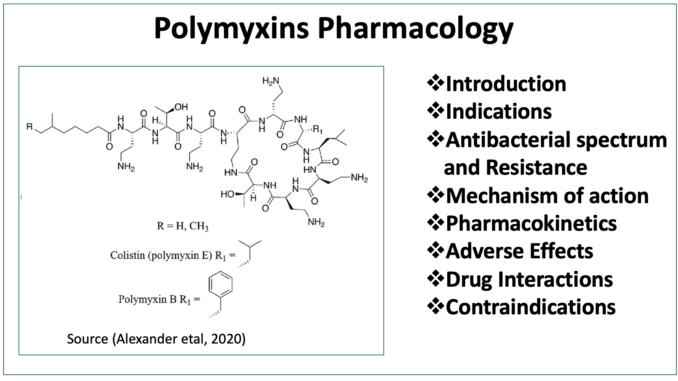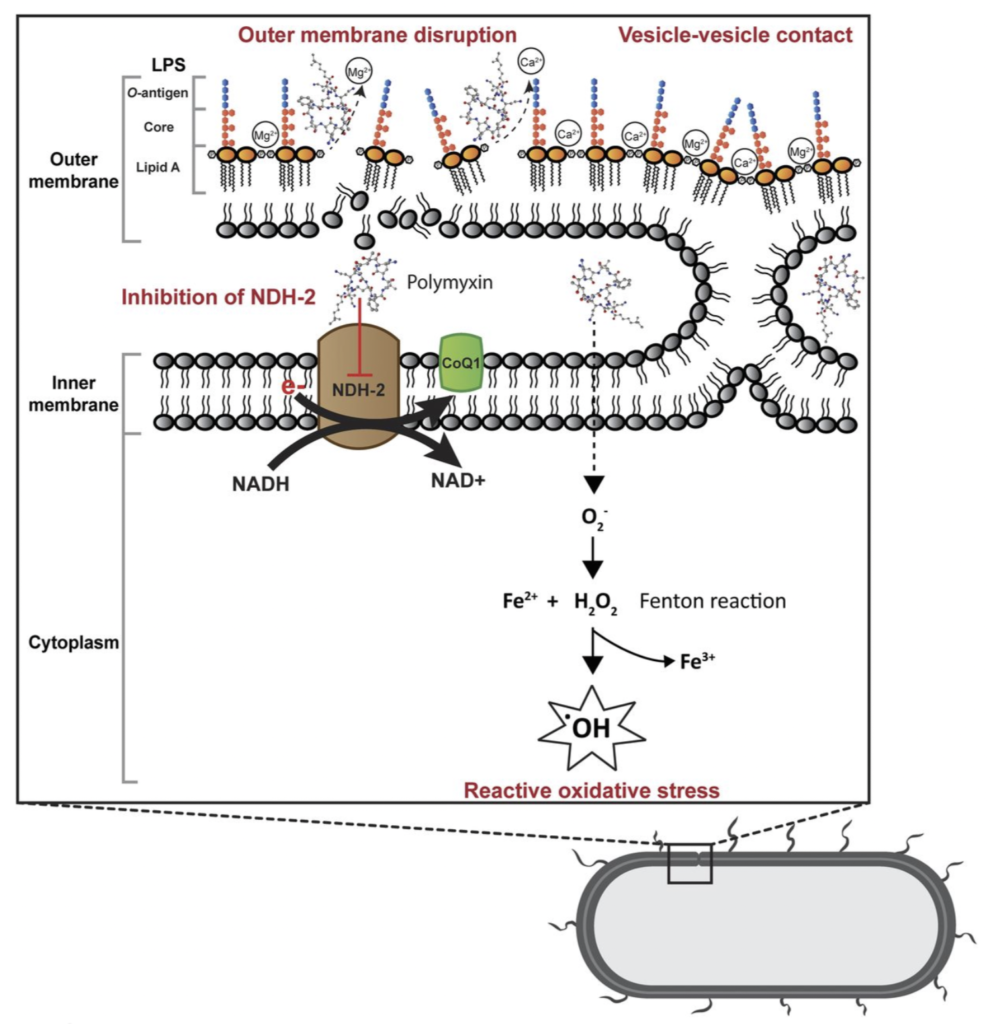
- Polymyxins are group of antibiotics having bactericidal activity against gram negative bacteria. There are two clinically available polymyxins- polymyxin B and colistin (polymyxin E). Polymyxins were discovered in 1940s. Due to their nephrotoxic and neurotoxic effects, their use decreases in 1970s. However, their use is in increased phase due to development of resistance to all other antibiotics.
- Polymyxins are nonribosomal cyclic lipopeptides and are cationic in nature. They are isolated from Bacillus polymyxa which is a gram-positive spore forming bacteria.
Indications of Polymyxins
- FDA approved for treating serious infections caused by multi-drug resistant gram-negative bacteria like P. aeruginosa, Enterobacteriaceae, K. pneumoniae and Acinetobacter baumannii. Used in treating infections of urinary tract, blood, and meninges.
- They are not used as first line agent. Most of the time, they are used as last line of agent after treatment failure with other infections.
Antibacterial spectrum
- Polymyxins are active against gram negative bacteria like P. aeruginosa, Legionella spp., E. coli, Klebsiella spp., Shigella spp. Etc. They have narrow anti-bacterial spectrum. They are not active against all gram-negative bacteria. Such bacteria include Providencia spp., Serratia spp., H. pylori, Brucella spp. Etc.
- They are not active against gram positive bacteria, anaerobic bacteria, parasites, and fungi.
Mechanism of action of Polymyxins

Figure- Mechanism of action of polymyxins in gram negative bacteria (Source- Nang SC, 2021)
- Polymyxins bind to lipopolysaccharide (LPS) present in outer membrane of gram- negative bacteria. Main function of this outer membrane is to act as barrier against toxic and notorious compounds. Lipid A- one of the three domain of LPS acts as important polymyxin binding target.
- The electrostatic interaction between lipid A and polymyxin leads to displacement of divalent cations: calcium and magnesium ions (these cations help to stabilize LPS) from phosphates of membrane lipids which destabilize the LPS. This causes cytoplasm leaking and ultimately leads to cell death.
- Polymyxin B can also bind to LPS released during bacterial lysis and hence can prevent toxic effect due to endotoxins.
Resistance
- Gram negative bacteria may develop resistance for polymyxin by different mechanism. One of such mechanism is modification of lipid A phosphates with positively charged groups. These positively charged groups reduce net negative charge of outer membrane of bacteria and prevent electrostatic attraction between polymyxin and outer membrane.
- Addition of fatty acyl chains to lipid A may also be responsible for development of polymyxin resistance.
Pharmacokinetics of polymyxins
- Polymyxin B sulphate is available for parenteral, ophthalmic, topical, and otic use. Colistin is available as prodrug- colistimethate sodium which is available for IV use or use via nebulizer. They don’t undergo oral absorption.
- Protein binding of polymyxin B is around 72 to 90%. Compared to colistin, polymyxin B achieve adequate drug concentration in rapid and reliable way. So, it is preferred than colistin.
Adverse effects
- Both polymyxin B and colistin have severe nephrotoxic and neurotoxic effect which have limited their use. Nephrotoxic effect of polymyxin B is less compared to colistin. Nephrotoxic effect may include oliguria, proteinuria, hematuria, and acute renal failure. Renal function of patients on polymyxin therapy should be monitored continuously. Neurotoxic effects include slurred speech, vertigo, dizziness, neuromuscular blockade, and paresthesia.
- Other less common adverse effects include allergic reaction like rashes, fever and urticaria.
- Safety study in pregnant and breastfeeding women, pediatric and geriatric patients has not been conducted
Drug Interaction
- They should not be used with other neurotoxic and nephrotoxic agents. Combination with other nephrotoxic agents like aminoglycosides should be avoided.
Contraindications
- Contraindicated in patients hypersensitive to polymyxins.
References
- https://www.ncbi.nlm.nih.gov/books/NBK557540/
- https://go.drugbank.com/drugs/DB00781
- https://journals.asm.org/doi/10.1128/CMR.00064-16
- Velkov T etal. Pharmacology of polymyxins: new insights into an ‘old’ class of antibiotics. Future Microbiol. 2013 Jun; 8(6): 10.2217/fmb.13.39.
- Nang SC etal. Rescuing the last line polymyxins- Achievements and Challenges. Pharmacological Reviews April 2021; 73 (2): 679-728.
- Pharmacology and Pharmacotherapeutics. 24th edition.
- Goodman and Gillman Manual of Pharmacology and Therapeutics.
- Lippincott Illustrated Reviews Pharmacology, 6th edition.